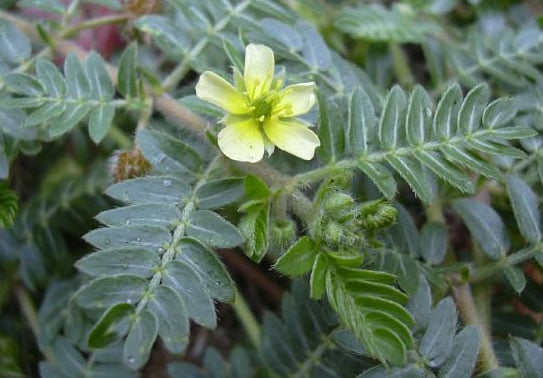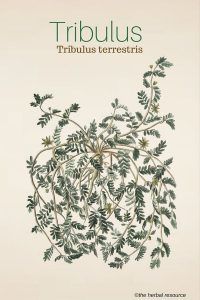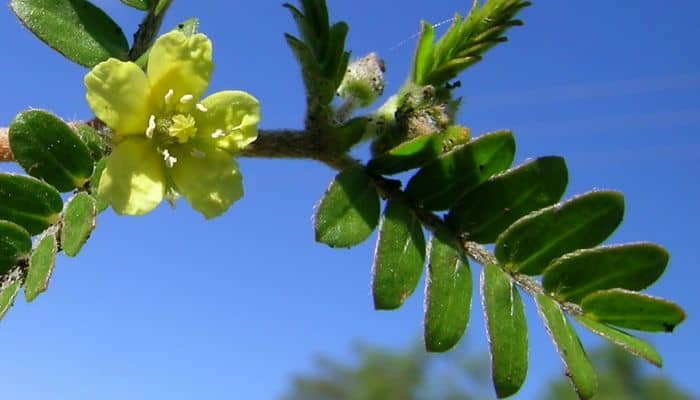Botanical Name: Tribulus terrestris.
Other Common Names: Puncture vine, caltrop, yellow vine, and goathead, abrojo de tierra caliente (Spanish), gokshura (Sanskrit), ci ji li (Chinese), Burzeldorn (German), croix-de-malte (French).
Habitat: Tribulus terrestris can be found in the moderate and tropical climates in Europe, America, Africa, Australia, and southern Asia.
Its name comes from the extreme sharp thorns that grow from the seed. The Latin word “tribulus” is translated as “caltrop” which means a peaked weapon.
It grows well in wild and uninhabited places and thrives in a moist sandy soil in full sun. It is considered a good forage plant for bees.
Cultivation of tribulus must be done with great caution because the species can in areas with suitable climate soon become a very troublesome weed. When the plant began to spread uncontrolled in California in the 1960s a snout-beetle had to be introduced from India to feed on the plant.
Plant Description: Tribulus terrestris blooms with small yellow flowers containing only 5 petals.
It grows with multiple stems that spring out from one crown. It has pinnate leaves made of two rows of little leaflets (less than a quarter-inch long), which are arranged opposite each other along the stem.
The fruit appears a week after blooming; its seeds are firm and stiff and have two sharp spines 10 mm long.
Plant Parts Used: The fruits are used in herbal medicine. They are collected when they are mature and dried for later use in decoction.
The young shoots and leaves can be boiled and used as a vegetable.
Therapeutic Uses, Benefits and Claims of Tribulus Terrestris
The main active ingredients of tribulus is believed to be kaempferol, kaempferol 3-glucoside, kaempferol 3-rutinoside, tribulosin and harmine.
It also contains active compounds called steroidal saponins which are mainly found in the leaf of the plant.
Tribulus terrestris was used as a weapon by South African tribes. The thorny seeds were collected, dipped in poison and then placed on the ground waiting for rival tribes to step on.
Tribulus seems to work by increasing the levels of luteinizing hormone. This hormone sends a signal through the body to start producing testosterone which is why it has become popular herbal remedy to increase libido and as an herb to improve fertility naturally.
There have been many studies in recent years aimed to validate the health benefits of tribulus. These studies have mostly been on animals and the results have been somewhat mixed. There seems that at least some of the health benefits of tribulus terrestris could be valid but better and bigger studies are needed in the future.
The popularity of tribulus as an herbal remedy for erectile dysfunction might be because of its ability to relax smooth muscles and by this allowing greater blood flow to the genitals.
Because of its claim to increase testosterone levels naturally, it has become a popular herb for bodybuilding and as a remedy to gain weight for men.
Although the above are some of its more commonly known uses it has been used traditionally for a variety of other ailments.
In Europe, China and India, herbalists have found some success in using tribulus as a natural treatment for lowering blood pressure and as an herb for high cholesterol
It has also been used traditionally for nervous disorders, constipation and to stimulate the central nervous system and for the treatment of some types of headaches.
Tribulus terrestris demonstrates anti-microbial and anti-tumor properties as well. Finally, in addition to the plant’s active substances which seem to lower cholesterol, it also appears to act as an antioxidant.
Some researchers are also getting positive results in the use of it for hypertension and diabetes treatment but more studies are needed.
Dosage and Administration
As a powder or capsule:
The usual dosage of tribulus terrestris is between 85 to 250 mg three times daily, with meals or as recommended by the manufacturer.
As a tea:
- 1. Grate, slice or powder 2g of tribulus tea.
- 2. Simmer in a pot for 20 minutes.
- 3. Strain and add sweetener as needed.
- 4. If powdered, add honey, mix into a paste and add hot water.
As an extract:
As recommended by the manufacturer.
Side Effects and Possible Interactions of Tribulus Terrestris
People with breast or prostate cancer or other hormone-dependent conditions should not use tribulus. Side effects such as anxiety, agitation, restlessness, and difficulty sleeping may occur with overdose.
Photosensitivity reactions can occur due to the substance phylloerythrin (photosensitizing porphyrin) found in the plant.
The herb is contraindicated for people suffering from stomach inflammation, ulcers, serious digestion or liver disorders. It may also cause a gastro-intestinal upset.
Tribulus terrestris is extremely toxic to sheep. It can cause irreversible disorder in the brain, resulting in impaired muscle function and weakness in the hindquarters which can lead to death.
Supporting References
Tierra, Michael & Lesley Tierra: Chinese Traditional Herbal Medicine. Vol. 2. Materia Medica and Herbal Resource. Twin Lakes. Lotus Press 1998
Bensky, Dan & Andrew Gamble: Chinese Herbal Medicine. Materia Medica. Seattle, Washington. Eastland Press Inc. 1993.
Molony, David: The American Association of Oriental Medicine’s Complete Guide to Chinese Herbal Medicine. New York. Berkley Books 1998.
Bown, Deni: The Royal Horticultural Society New Encyclopedia of Herbs & Their Uses. London, England. Dorling Kindersley 2002.
Duke, James A.: Handbook of Medicinal Herbs. Boca Raton, Florida. CRC Press 2002.
Thordur Sturluson
Latest posts by Thordur Sturluson (see all)
- What is the Difference Between Hemp and Marijuana? - June 3, 2019



Leave a Reply